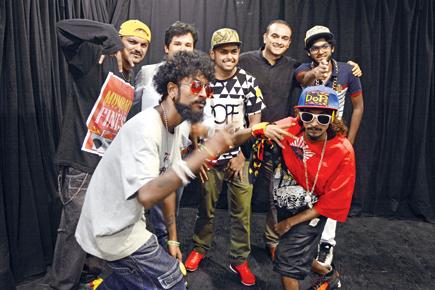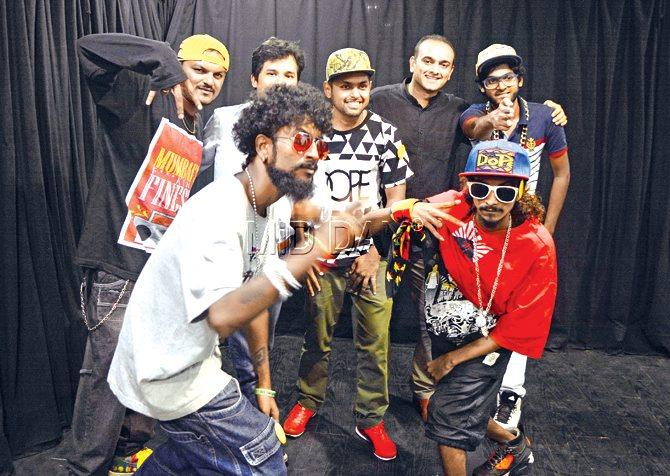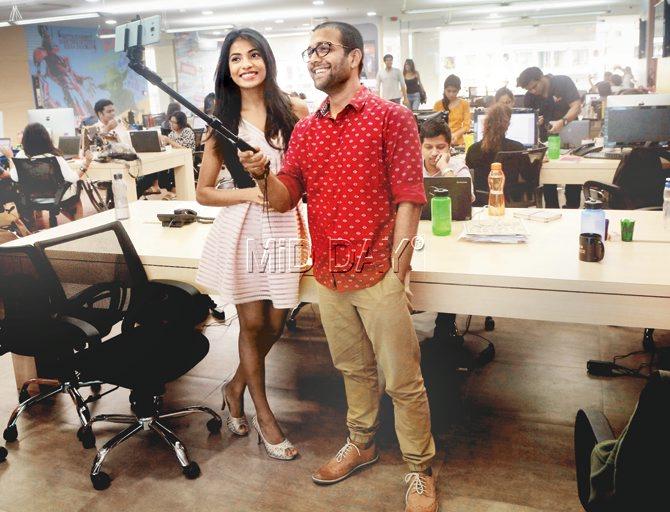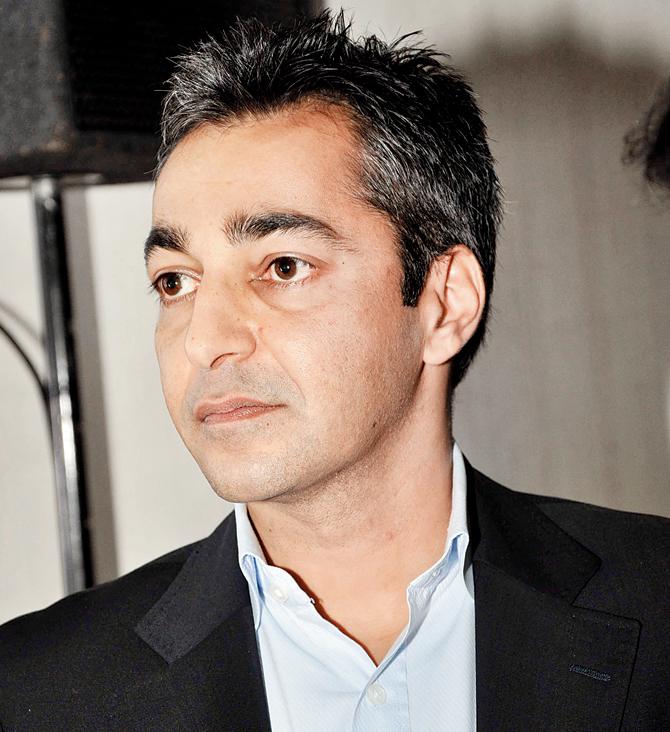Sniffing out the best amateur talent to prepare for showcase on their online entertainment networks, this set is making money off making others famous

Hip hop groups Dopeadelicz, SlumGods, and rapper Ace pose with Qyuki founder and managing director, Samir Bangara and head of content, Sagar Gokhle
ADVERTISEMENT
It’s a fact. We now watch everything online. So, if someone wanted to make it big on the entertainment scene, it would make sense to get online.
But getting there is easy and and getting big isn’t. For amateur talent to go viral, they need a platform, grooming lessons, infrastructure and aggressive marketing.
Start-ups that seem to have noticed this need are building businesses around turning online talent into household names.
Here’s a look at how it’s done, why and what’s in it for everyone.

Hip hop groups Dopeadelicz, SlumGods, and rapper Ace pose with Qyuki founder and managing director, Samir Bangara and head of content, Sagar Gokhle. Pic/Bipin Kokate
#Fame
The stars: Abhiruchi Singh, Audrey D’Silva
Launched in September 2014, #fame’s billboards across Mumbai are hard to miss. One sees director Karan Johar present himself as host of their Lakmé School of Style. Another has amateur talent, singer Abhiruchi Singh pose sweetly. It’s this strategy of combining marquee names with upcoming talent that is serving the digital entertainment firm well. Their app, a live beaming one, launched three months ago has hit the one million download mark.
It sees 40,000 registered performers, and that’s only the latest feather in their cap. Their talents range from singer Abhiruchi Singh (12,000 followers) and love guru Audrey D’silva (13,000) to comic Sikandar Sidhu (his channel ranks eight among top comedy channels on YouTube) and Simran Kapoor (her playlist Simran ka Siyaapa discusses taboo subjects and daily issues). Their success is surprising.
Kapoor boasts 10 million views in just eight months. And #fame’s role is simple but significant. If you are a singer, they will help record your song, make a video for it, put it up on their channel on YouTube, market it, and you, ceaselessly. They will push you onto social platforms, while drumming up hype around you. Singh landed a gig at this year’s Kala Ghoda Arts Festival, and even received a corporate gig invite from a travel firm when she was performing live on the app one night.
So, what’s in it for #fame?

Ankit Vengurlekar, VP (Content) at #fame and relationship advice guru Audrey D'Silva, who has 13,000 followers on the #fame app. Pic/Sayed Sameer Abedi
Their revenue model, says founder and CEO, Saket Saurabh, is sponsorship and advertising driven. Brands like Ola, Myntra, Honda and Unilever, he says, have discovered that it’s about content-led marketing. “We are not thinking of making money off them. The money comes from brand-related promotion,” says Ankit Vengurlekar, VP (content).
Which is why, the wannabe star spends nothing; simply showcases talent. D’Silva, 23, who won an online reality show on #fame called The Beauty and the Blogger last year, is now the app’s top performer. “Although I was second runner-up at Miss India World Worldwide in 2014, and acted in serials like CID, nobody knew me until now,” she says.
Singh, who sang the official remix of Ayushman Khurana’s Paani Da Rang two years ago, is a middle-class girl who hails from Bareilly but lives in Delhi. The 23-year-old can’t believe her luck. She was signed by #fame last year and her first original single, Ud Chali, was recorded and produced entirely by the start-up. “I interact with some 250 viewers when I perform live on the app for 40 minutes every night at 10.30 pm. So many talented people want to make it big, but how many get the chance?”
Saurabh compares the online entertainment boom to the time cable TV came to India. “It changed the ecosystem of entertainment. We found new stars. The digital revolution is doing the same. If you want to be a star, why wait in queues at auditions and at casting offices? It’s not a one in million gamble anymore. The hashtag in #fame stands for inclusiveness. Fame is for everyone.”
And they mean it. Creating close to 150 videos every month that screen on YouTube, Facebook, WeChat and Daily Motion, it has grown into the country’s largest original content creator for mobile and web platforms. #Fame raised $10 million in a second round financing from To The New Ventures (TTN Ventures), Singapore in January. This round follows the $3 million investment TTN Ventures had made when the business began in beta, in early 2014.
In January this year, #fame had hoped to hit the 5,000 channels and 50,000 content providers mark in the next three years. But their app’s success turned the projection on its head, allowing them to hit the 40,000 mark in just four months.
Qyuki
The stars: Dopeadelicz, SlumGods
It calls itself India’s first elite creator network and has music composer AR Rahman and director Shekhar Kapoor backing it. Launched in 2013 along with Samir Bangara, Qyuki has over 200 artistes and relies on the trio’s potential-spotting prowess. “We call them the super algorithm. They decide whether the talent can go the long run. We choose artists who exhibit commitment towards attacking this form of content creation. You have to have the discipline to continuously create,” says Bangara. The company, which aims to capture the imagination of 13 to 24-year-olds (Bangara says they have the “virility to drive content since they are the generation born into it”), has a host of talent onboard. SlumGods is a Dharavi-based hip hop group that hopes to up the shantytown’s image via dance. Dopeadelicz is made up of Dharavi’s rapping trio Tony Sebastian, Agnel Avinash Benson and Rajesh Radhakrishnan. Former actress, now socialite, Pooja Bedi and her daughter Alia appear on a channel called Effn’ Bedi where the two discuss life.

Gautam Anand, Director, Content & Partnership, Asia Pacific, YouTube
Interestingly, in addition to infrastructure across studios in Mumbai, Bengaluru and Chennai, the firm also has a studio in Dharavi that it hopes will nurture talent in Mumbai’s shadow city. “We don’t have a channel of our own, but we tie up with artistes and help push their YouTube channels. This is done through connecting artistes to brands like Coca Cola and Olx,” Bangara explains. Singer Shraddha Sharma, one of the early YouTubers, was signed by Qyuki in November 2014, and already has 3.7 million Facebook fans and 180,000 subscribers on her channel.
The exposure Dopeadelicz has received helped them perform on Coke Studio this season. Aby, 22, a Dharavi resident, is key member of SlumGods. The soft-spoken rapper says, “Online is the way to go, and if a company like Qyuki won’t help me create content, how am I going to do it?”
YouTube
The stars: Sherry Shroff, All India Bakchod
In March this year, the mothership, YouTube, held its second fanfest in Mumbai. On stage were some of the biggest YouTubers from around the country — comics Kanan Gill and Biswa Rath, lifestyle blogger Sherry Shroff, and comedy collective All India Bakchod. These guys shared space with international YouTubers Bethany Mota and singer Kurt Schneider.
The message was clear — YouTube was out to promote popular, homegrown talent, and the focus was on collaboration.
As Gautam Anand, Director (content & partnership), puts it, “That’s one of the biggest ways YouTube promotes its creators.

Beauty blogger Shruti Anand, one of Culture Machine’s talents
We help them collaborate with other talent. This way, they can benefit from each other’s audience.” Although YouTube doesn’t help produce content, they push creators by holding regular workshops that explain how the video-sharing website can be used more effectively. Gayatri Sharma, a Mumbai homemaker, plays chef on YouTube on her channel Gayatri Vantillu (which means kitchen), and has around 41,000 followers. “Since I was already popular, they invited me to various YouTube events.”
Culture Machine
The stars: Enna Da Rascalas, Shruti Anand
Home to YouTube talent like beauty blogger Shruti Anand, make-up artist Elton Fernandes and musicians Enna Da Rascalas, Culture Machine is all about production, promotion and marketing of talent. The digi media firm (launched in 2013) for the Internet generation is backed by Tiger Global, an American venture capitalist firm that also funded Flipkart, and Zodius Capital, a city-based firm. Culture Machine helps produce original content that is then marketed on Twitter, Instagram and Facebook. “Enna Da Rascalas has around 52,000 subscribers on Youtube; Shruti Anand has about 2.5 lakh,” says Sameer Pitalwalla, CEO and co-founder, matter-of-factly. Rascalas’s first video worked towards trashing stereotypes that surround South India, its five states and four languages. Created to the tune of We Didn’t Start the Fire, the spoof won her instant fans. Their monetisation module is three pronged – organic YouTube advertising, branded content and syndication, which involves showing content on platforms other than YouTube. The litmus test, says, Pitalwalla, comes after content is produced. “It’s about promoting it as much as you can. We are all about that.”
 Subscribe today by clicking the link and stay updated with the latest news!" Click here!
Subscribe today by clicking the link and stay updated with the latest news!" Click here!







